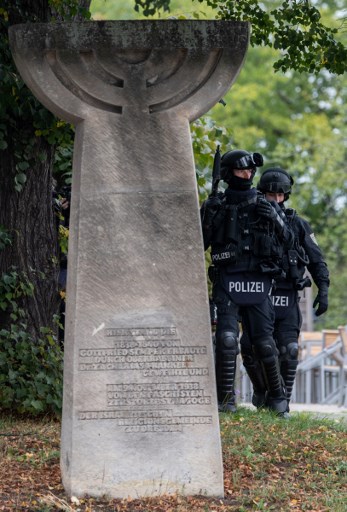Yom Kippur shooting victims named: Jana Lange and Kevin S.
The two victims in the Yom Kippur shooting at a synagogue in Halle, Germany have been named as Jana Lange, 40, and Kevin S., 20.
Lange was shot by extremist anti-Semite Stephan Balliet, who livestreamed the attack via a helmet camera as she attempted to stop him from shooting up the synagogue.
Balliet went on to shoot Kevin, whom local media described as a soccer fan, who was at a nearby kebab stand during the terrorist attack.
German media described Lange as a "warm, funny" person and a devoted music lover. She liked to share pictures of artists she admired on social media.
Kevin, the second victim, was a painter. He worked at a building site near the synagogue.
Kevin's father began to fear the worst when reports about the shooting began to circulate.
"All we know is that you're at the construction site nearby and you lost your phone. Kevin, we love you more than anything," the father wrote on his Facebook page prior to receiving the news of his son's tragic death.
Ousted From CNN For Hezbollah Tweet, Octavia Nasr Returns as Producer at Taxpayer-Funded News Outlet Alhurra
The U.S.-funded Arabic channel Alhurra TV recently brought on Octavia Nasr, a former CNN senior editor who left the network after publicly expressing sympathies for a Hezbollah-tied cleric, as a consultant tasked with helping lead the outlet’s revamp.BDS and antisemitism: Examining the Ministry of Strategic Affairs Report
Nasr has largely been out of journalism work for the past decade after losing her role as CNN’s editor of Mideast affairs. Her demise at the network she worked at for two decades came after she used her CNN Twitter account to praise Sayyed Mohammad Hussein Fadlallah, a highly controversial Shia cleric who supported Islamist terrorist attacks and was regarded as the spiritual leader for Hezbollah, a militant group based in Lebanon. The U.S. State Department currently labels Hezbollah a foreign terrorist organization.
“Sad to hear of the passing of Sayyed Mohammad Hussein Fadlallah. One of Hezbollah’s giants I respect a lot,” wrote Nasr in July 2010.
A source who spoke to Mediaite about Nasr’s role at the outlet said she acted as a producer, assisting the network with how they covered subjects and what details they decided to omit or include in their reporting.
When reached for comment, Alhurra’s spokesperson described Nasr’s role at the outlet as “a consultant on technical issues,” but claimed she has “completed her contract.”
“MBN is an equal opportunity employer. The company does not discriminate on any basis,” the spokesperson added in response to questions about Nasr’s past employment issues.
Nasr did not respond to Mediaite’s requests for comment.
In recent days, Israel’s Strategic Affairs Ministry published a report documenting some 100 examples in which activities of the Boycott, Divestment and Sanctions (BDS) campaign qualify as antisemitic, based on the International Holocaust Remembrance Alliance (IHRA) working definition of antisemitism, which has been adopted by 15 countries and by the European Parliament. Given the difficult task of operationalizing what antisemitism is, all cases documented in the report manifest at least one of the following characteristics: expressions of classic antisemitism; Holocaust inversion; and denial of the Jewish people’s right to self-determination.
Three central claims emerge from the more than 90-page report.
• One: Delegitimization and demonization of the State of Israel by the BDS movement invariably results in the stigmatizing of Jews worldwide and in Israel.
• Two: Some members of the BDS leadership are antisemitic.
• Three: The argumentation patterns and methods of the BDS movement – which include the denial of the Jewish people’s right to self-determination in their ancestral homeland and the singling out of Israel for boycott – are antisemitic.
It is worth scrutinizing each of these conclusions separately.
• The first point, which links the delegitimization of Israel spearheaded by BDS to the stigmatization of Jews, is also reflected in research conducted by the Institute for National Security Studies, based in large part on interviews with members of Jewish communities across the globe. We have seen this phenomenon play out in the personal security sphere. One domain in which the connection between BDS and manifestations of antisemitism is most readily traced in our research is the academic realm.
In this setting we found that Jewish (and Israeli) students studying on campuses outside of Israel fear for their personal safety, are intimidated by BDS activists, and experience obstacles related to their Jewish identity in competing for student leadership positions. While it is impossible to trace every antisemitic manifestation experienced by students to BDS, the ministry’s report is instrumental in demonstrating the connection between BDS and antisemitism on campus life through the documentation of antisemitic imagery and rhetoric adopted by student BDS-promoting organizations.






































.jpg)



